In the rapid digital world today, mobile devices are the quickest way for users to interact with online content.
That fact makes mobile optimization of your Google Ads campaigns indispensable in making sure your target audience is reached effectively.
Mobile optimization is no longer optional; it’s an integral part of every successful digital marketing strategy.
With mobile-optimized advertisements, you can dramatically enhance the quality of the user experience, improve click-through rates (CTRClick-Through Rate, a metric that measures how often people click on your ad after seeing it.), and drive conversions.
This article will dive deep into best practices and strategies for mobile optimization within Google Ads so that you remain competitive in the mobile advertising landscape.
- Why Mobile Optimization Matters in Google Ads
- Best Practices for Mobile Optimization in Google Ads
- Targeting Strategies for Mobile Audiences
- Measuring Success: Mobile Optimization KPIs
- Common Mistakes in Mobile Optimization for Google Ads
- Mobile Optimization: The Key to Success of Google Ads Campaigns
- Google Ads Mobile Optimization: Frequently Asked Questions
Why Mobile Optimization Matters in Google Ads
As mobile traffic continues to gain momentum in the digital space, it has become imperative for marketers looking to achieve their business goals to optimize their Google Ads campaigns for mobile devices.
Why is mobile optimization so critical?
First of all, more than 50% of all web traffic is generated via mobile devices, and this percentage keeps increasing steadily.
If your ads are not optimized for mobile, it’s like losing a big part of those potential customers.
Huge bounce rates and lost opportunities are often the result of slow-loading landing pages and poorly formatted ads on mobile devices.
This is why mobile optimization is important—it’s not just about reaching mobile users, but creating an experience that seamlessly converts them into customers.
If your ad is optimized for mobile, you can expect better CTRs, improved quality scores, and more conversions.
Visually appealing, fast-loading, and user-friendly ads create a more interactive format that translates into higher campaign performance.
Also, note that Google rewards mobile-friendly content.
The better your ads perform on mobile, the more likely they are to receive higher rankings in search results.
Not only will this enhance your exposure, but it will also lower your cost-per-click (CPCCost-Per-Click, the amount an advertiser pays for each click on their ad.), as Google incentivizes ads that create a great user experience.

A visual contrast between mobile and desktop user behaviors in digital advertising, showcasing different interaction styles and engagement.
Mobile User Behavior vs Desktop User Behavior
Mobile users are very different from desktop users in several key ways.
They are often on the move, seeking immediate answers or quick solutions to their problems.
This means that ads and landing pages should be designed for speed and simplicity.
Mobile users won’t spend time navigating through complicated pages or waiting for slow content to load.
Mobile users also tend to engage with ad types differently than desktop users.
For instance, mobile search ads, in-app ads, and mobile video ads tend to perform better on mobile devices than regular display ads.
By understanding these behavior patterns, you can tailor your Google Ads campaigns to better cater to the needs of mobile users—leading to better engagement and higher conversion rates.
Mobile optimization is crucial for Google Ads because it ensures a better user experience, leading to improved CTR and conversions. By prioritizing mobile traffic, advertisers can reduce costs and boost overall campaign effectiveness.

An illustration of best practices in mobile optimization for Google Ads, focusing on responsive design, fast load times, and improved user experience.
Best Practices for Mobile Optimization in Google Ads
The success of a Google Ads campaign on mobile devices requires adherence to best practices for mobile optimization.
Mobile users seek fast, easy experiences, and failure to provide such experiences risks missed opportunities.
Below are some of the best practices you should have in place to ensure that your ads are performing well on mobile.

An illustration of a mobile-friendly landing page, showcasing simple navigation, fast loading, and user-friendly design for optimized mobile experiences.
Designing Mobile-Friendly Landing Pages
One of the foremost steps in mobile optimization is making sure that landing pages are fully optimized for mobile.
Landing pages can be thought of as the place where potential customers interact with your content after clicking on your ad.
As such, they need to provide a seamless user experience.
A mobile-friendly landing page should load quickly, have clear calls to action, and be easy to navigate.
Below are some tips for optimizing landing pages:
- Responsive Design: Ensure your landing page uses a responsive design that automatically fits any screen size, whether mobile, tablet, or desktop.
- Page Load Speed: Mobile users expect instant loading times. Use free tools like Google’s PageSpeed Insights to diagnose and fix performance issues that slow down your landing page.
- Simplified Navigation: Mobile users prefer minimal, intuitive navigation. Minimize clutter to make it easy for users to find what they want quickly.
- Clear CTAs: Use bold and easy-to-tap call-to-action buttons that are noticeable and encourage users to take action.
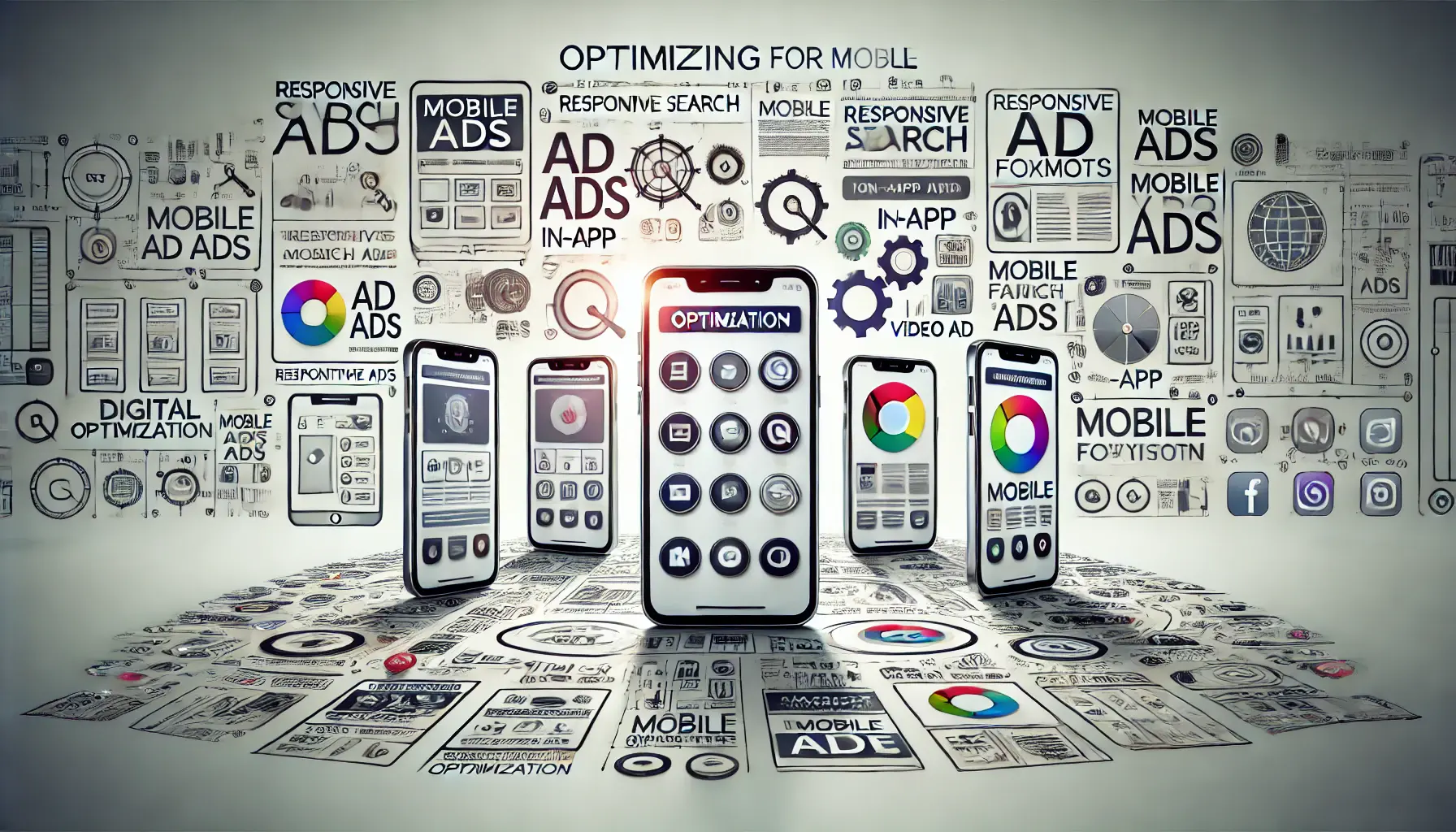
An illustration of optimized mobile ad formats such as responsive search ads, in-app ads, and mobile video ads, emphasizing mobile-specific optimization.
Optimizing Ad Formats for Mobile Devices
Google Ads offers various ad formats, and some perform better on mobile devices than others.
Optimizing your ad formats can make a significant difference in user engagement and overall campaign success.
Here are some ad formats you should focus on:
- Responsive Search Ads: These ads automatically adjust their size, appearance, and format to fit different mobile devices, making them ideal for mobile optimization.
- In-App Ads: Since mobile users spend most of their time in apps, leveraging in-app advertising can increase visibility and drive conversions.
- Mobile Video Ads: Video content is highly engaging, especially on mobile. Short, captivating mobile video ads can significantly improve user interaction and conversion rates.

An illustration showing how mobile-specific ad extensions like call, location, and app download improve user engagement in mobile advertising.
Leveraging Mobile-Specific Ad Extensions
Ad extensions are a great way to add more information to your mobile ads and improve their performance.
Mobile-specific ad extensions enhance user experience by offering additional features tailored for mobile users.
Some of the most effective mobile-specific ad extensions include:
- Call Extensions: Allow users to call your business directly from the ad with a simple tap.
- Location Extensions: Show users your business location and drive foot traffic by integrating Google Maps with your ads.
- App Extensions: Direct users to download your mobile app straight from the ad, increasing app installs and engagement.
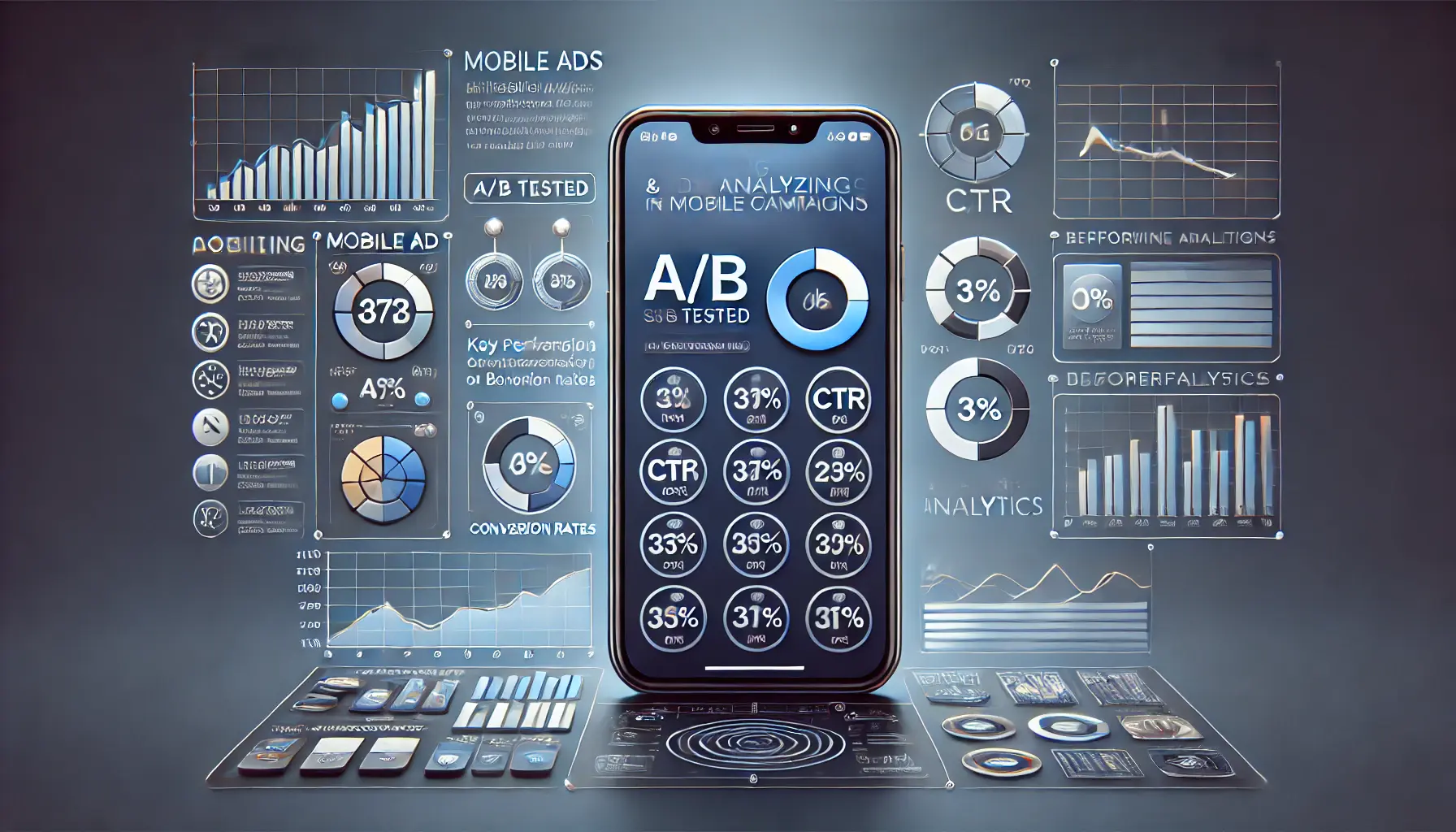
An illustration representing the process of testing and analyzing mobile ad campaigns using A/B testing and key performance data.
Testing and Analyzing Mobile Campaigns
Ongoing testing and analysis of your campaigns are crucial for the success of your mobile optimization efforts.
A/B testing can be used to compare different creative formats, landing pages, and calls to action to see which perform better.
Use Google’s analytics tools to track key metrics such as CTR, conversion rates, and bounce rates, focusing specifically on mobile traffic.
By consistently observing performance, you can fine-tune your campaigns to optimize for mobile and achieve better results.
Mobile optimization is an ongoing process, but by implementing these best practices, you can improve the performance of your Google Ads campaigns on mobile devices and ensure a better user experience that leads to higher conversions.
Implementing best practices like responsive design, fast page load times, and simplified navigation are essential for optimizing Google Ads campaigns for mobile devices.

An illustration representing mobile audience targeting strategies, highlighting location-based targeting, demographics, and device bidding for improved ad engagement.
Targeting Strategies for Mobile Audiences
Targeting mobile audiences on Google Ads differs significantly from targeting desktop users.
Mobile users have unique behaviors and preferences, and understanding these subtleties helps in framing effective mobile optimization strategies.
By optimizing your audience targeting specifically for mobile devices, you can reach the right users, engage them better, and ensure conversions.
Below are some proven strategies to reach mobile audiences effectively.

An illustration showing the concept of mobile location-based targeting, where ads are delivered based on users’ geographical locations.
Mobile Location-Based Targeting
Location-based targeting is one of the most powerful tools for mobile ads.
As most mobile users are frequently on the move, they are more likely to engage with ads that are relevant to their current location.
With Google Ads, you can set up geo-targetingThe practice of delivering content or advertisements to users based on their geographic location. options to reach users in specific geographic areas—from broad country-level targeting to very narrow radius-around-business targeting.
Here’s how to take advantage of location-based targeting:
- Radius Targeting: Use radius targeting to show ads to users who are within a certain distance of your physical store, driving local foot traffic and increasing offline conversions.
- Location-Based Offers: Tailor your ads to include location-specific offers or promotions, such as special discounts for customers near your store.
- Localized Keywords: Use location-based keywords in your ads to match user intent and ensure your mobile ads are highly relevant to users’ needs based on their location.
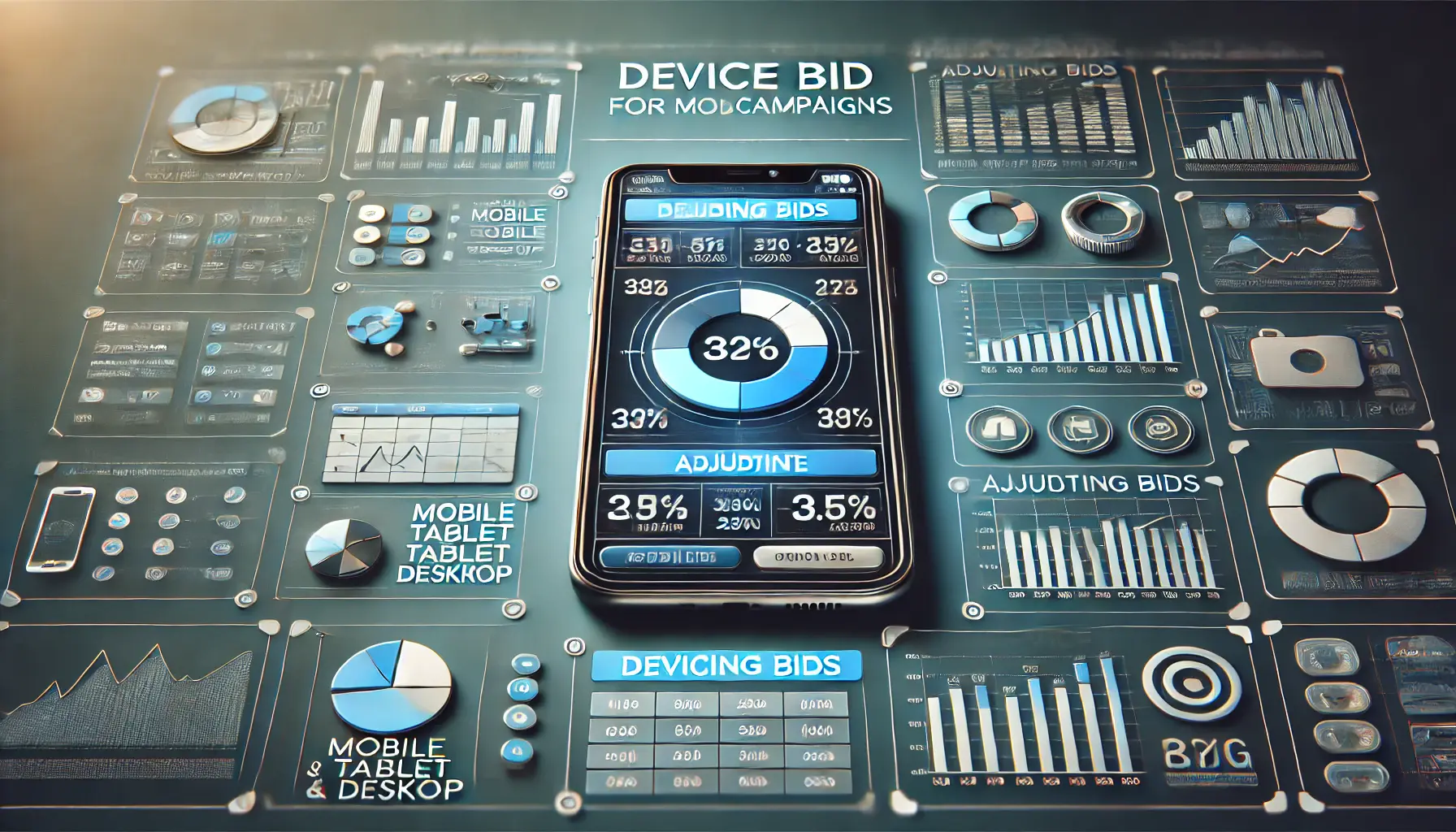
An illustration showing how device bid adjustments for mobile campaigns optimize ad performance by strategically managing bid settings across various devices.
Device Bid Adjustments for Mobile Campaigns
One of the most important steps for any mobile ad campaign is adjusting your bids based on the devices your target audience is using.
Google Ads allows you to set bid adjustments for mobile devices, enabling you to prioritize mobile traffic and allocate your budget more effectively.
Here’s how to optimize your bids for mobile devices:
- Increase Mobile Bids: If your campaigns perform well on mobile, consider increasing your mobile bids to capture more traffic.
- Analyze by Device: Regularly monitor how your ads perform on desktop, mobile, and tablet, and adjust your bids accordingly to maximize results.
- Mobile-First Approach: For businesses heavily reliant on mobile traffic, such as e-commerce or app-based businesses, a mobile-first bidding strategy is essential.
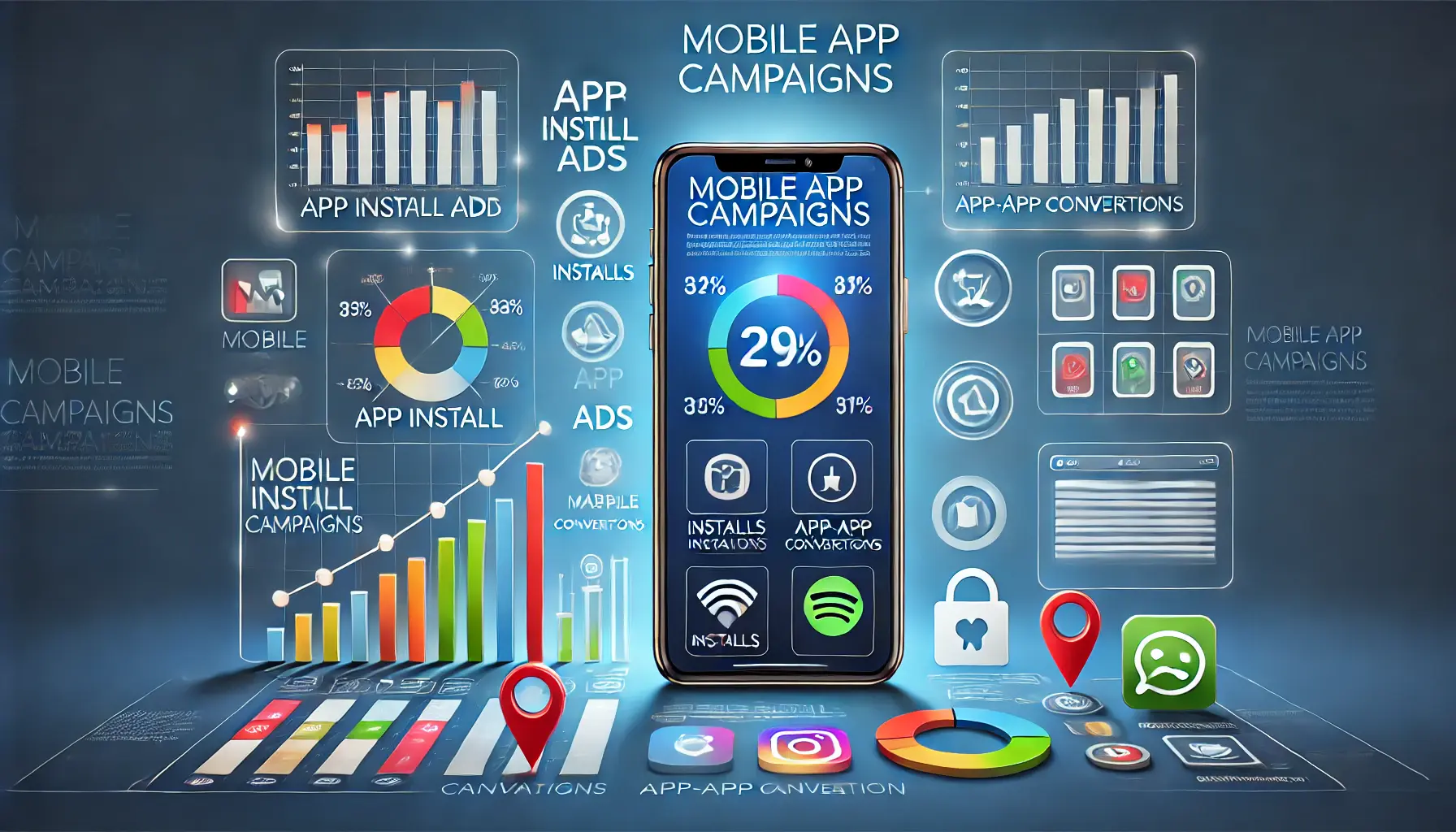
An illustration showing mobile app campaigns in action, highlighting app install ads and analytics for tracking key performance metrics such as installs and user engagement.
Understanding and Using Mobile App Campaigns
Mobile app campaigns use machine learning to automatically optimize your ads for mobile users, showing them in places like Google Search, YouTube, Google Play, and other apps.
Here are the key aspects of mobile app campaigns:
- Automated Targeting and Bidding: Google Ads will automatically adjust bids and targeting based on your campaign goals, whether to maximize app installs or in-app conversions.
- Ad Variations: Provide various ad assets—text, video, images—and Google will automatically test which combination performs best for mobile users.
- App Store Integration: These ads can direct users to your app’s page on Google Play or the App Store, streamlining the download process for mobile users.

An illustration showing how cross-device targeting in digital advertising enhances conversion rates by delivering synchronized ads across multiple devices.
Cross-Device Targeting for Improved Conversions
Cross-device targeting is essential in modern campaigns, as users often switch between devices during their purchase journey.
A user may start a search on their smartphone but complete the conversion on their desktop.
Cross-device targeting allows you to reach users seamlessly across multiple devices while maintaining consistency in your messaging.
Here’s how to optimize your cross-device strategy:
- Segmenting Audiences: Use audience data to create segments that follow users across devices, ensuring they see relevant ads whether they’re on mobile or desktop.
- Cross-Device Conversion Tracking: Set up cross-device conversion tracking to capture how users interact with your mobile and desktop ads, giving you a full picture of your campaign’s performance.
- Seamless Messaging: Ensure a consistent ad message and user experience across all devices so users can easily pick up where they left off, whether switching from mobile to desktop or vice versa.
Location-based targeting and device-specific bid adjustments can significantly improve the performance of mobile ads by ensuring your ads reach the right users at the right time.

An illustration representing the tracking and analysis of mobile optimization KPIs such as CTR, conversion rates, and bounce rates for measuring success.
Measuring Success: Mobile Optimization KPIs
For any mobile optimization to be deemed successful in Google Ads, it’s essential to measure performance using key performance indicators (KPIs).
These metrics help your business understand whether your mobile ads are performing well or if adjustments are needed.
By focusing on mobile-specific KPIs, you can make data-driven decisions to increase engagement, conversions, and ROI.
Here are the most important KPIs you should track when optimizing for mobile.
An illustration representing mobile-specific conversion tracking, highlighting the tracking of app installs, form submissions, and purchases to measure mobile campaign success.
Mobile-Specific Conversion Tracking
Tracking conversions from mobile devices is crucial in measuring the success of your mobile-driven campaigns.
Google Ads allows you to set up conversion tracking specifically for mobile users.
This helps you discover how users interact with your ads and how many take the desired actions, such as making purchases or signing up for services.
Key features of mobile conversion tracking include:
- Mobile App Conversions: Track important actions, like in-app purchases or other interactions, that users complete after viewing your ads.
- Mobile Website Conversions: Set up conversions for mobile users visiting your website, tracking actions such as form submissions, purchases, or phone calls.
- Cross-Device Conversions: Measure how users start a conversion on one device, like mobile, and complete it on another, such as a desktop. This provides a more accurate view of the customer journey.

An illustration representing the analysis of bounce rates and session durations in mobile advertising, helping measure user engagement and page effectiveness.
Analyzing Bounce Rates and Session Durations
Bounce rates and session durations are critical metrics that help evaluate how well your mobile landing pages are performing.
A high bounce rateThe percentage of visitors who navigate away from the site after viewing only one page. indicates users are leaving your site without interacting, which could be due to slow load times or a poor user experience.
Here’s what to focus on:
- Mobile Bounce Rate: Monitor how many users land on your mobile page and leave without taking further actions. A high bounce rate may point to poor mobile optimization, such as slow page speeds or confusing navigation.
- Session Duration: Track how much time users spend on your mobile site. Longer sessions typically indicate that users find your content engaging, while shorter sessions may signal a need for better optimization to improve the user experience.
- Page Speed Optimization: Ensure your mobile landing pages load quickly, as slow page speed is one of the top reasons for high bounce rates on mobile devices.
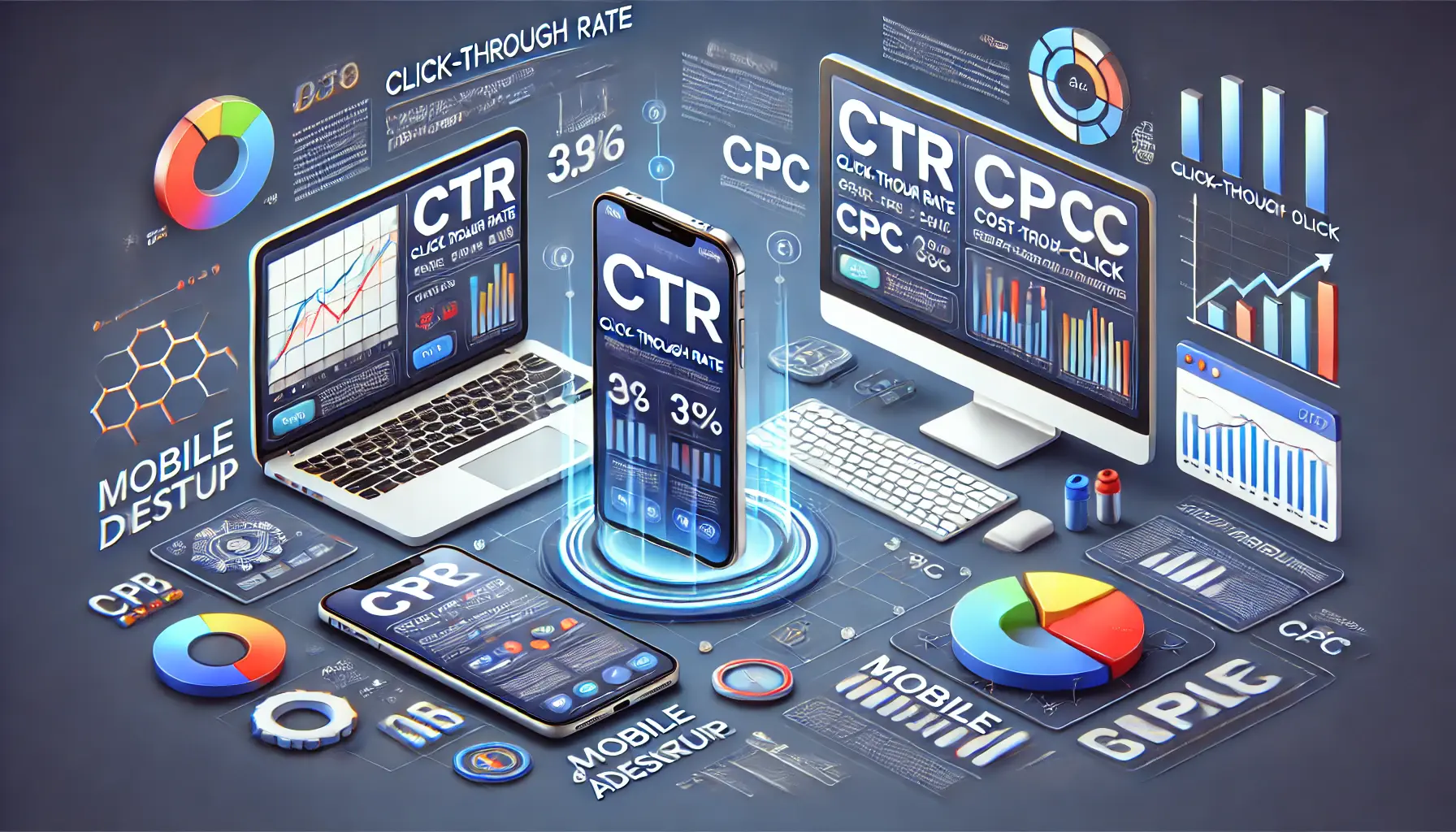
An illustration showing the comparison of CTR and CPC metrics between mobile and desktop advertising, highlighting differences in ad performance.
CTR and CPC Differences on Mobile vs Desktop
Click-through rate (CTR) and cost-per-click (CPC) are important KPIs that often vary between mobile and desktop.
Understanding these differences allows you to optimize your bidding strategy and ad formats.
Consider the following:
- Mobile CTR: Mobile devices tend to have higher CTRs than desktop, due to the immediate and personal nature of mobile. Monitor your mobile CTR to determine if your ads are resonating with mobile users.
- Mobile CPC: While mobile ads may drive more clicks, CPC can vary based on competition and ad relevance. Analyze your mobile CPC to ensure you’re getting the best return on ad spend.
- Bid Adjustments: Use data from CTR and CPC comparisons between mobile and desktop to adjust your bids, allocating more budget to the platform that delivers the best results.
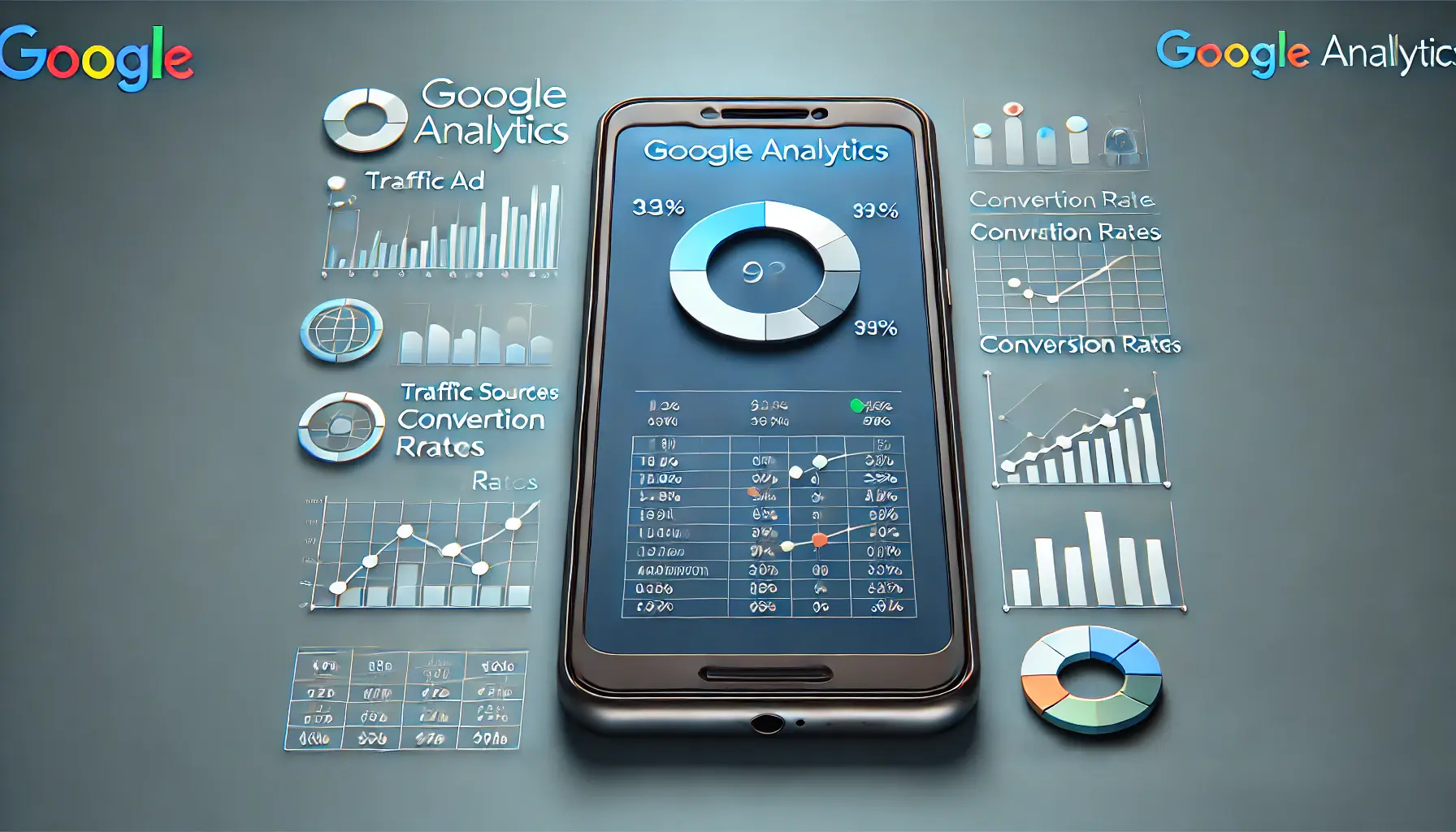
An illustration showing the use of Google Analytics to evaluate mobile ad performance by tracking key metrics like traffic, conversions, and bounce rates.
Evaluating Mobile Ad Performance with Google Analytics
Google Analytics offers valuable insights into how your mobile ads and landing pages are performing.
By integrating Google Ads with Google Analytics, you can track cross-device behaviors and evaluate your mobile campaigns for data-driven optimizations.
Here’s how to use Google Analytics for mobile optimization:
- Mobile vs Desktop Comparisons: Use Google Analytics to compare key metrics such as bounce rate, session duration, and conversion rate between mobile and desktop traffic, identifying areas where further mobile optimization is needed.
- Behavior Flow Reports: Analyze the mobile user journey on your site, pinpointing where users drop off or convert. This helps identify problem areas in the mobile user experience.
- Custom Mobile Reports: Create custom reports within Google Analytics to focus on mobile traffic, tracking KPIs like mobile conversions, bounce rates, and time on site.
By consistently tracking and analyzing these KPIs, you can optimize the performance of your mobile campaigns in Google Ads and provide a better experience for mobile users.
Key performance indicators like CTR, conversion rates, and mobile bounce rates are crucial metrics for tracking the success of mobile-optimized Google Ads campaigns.
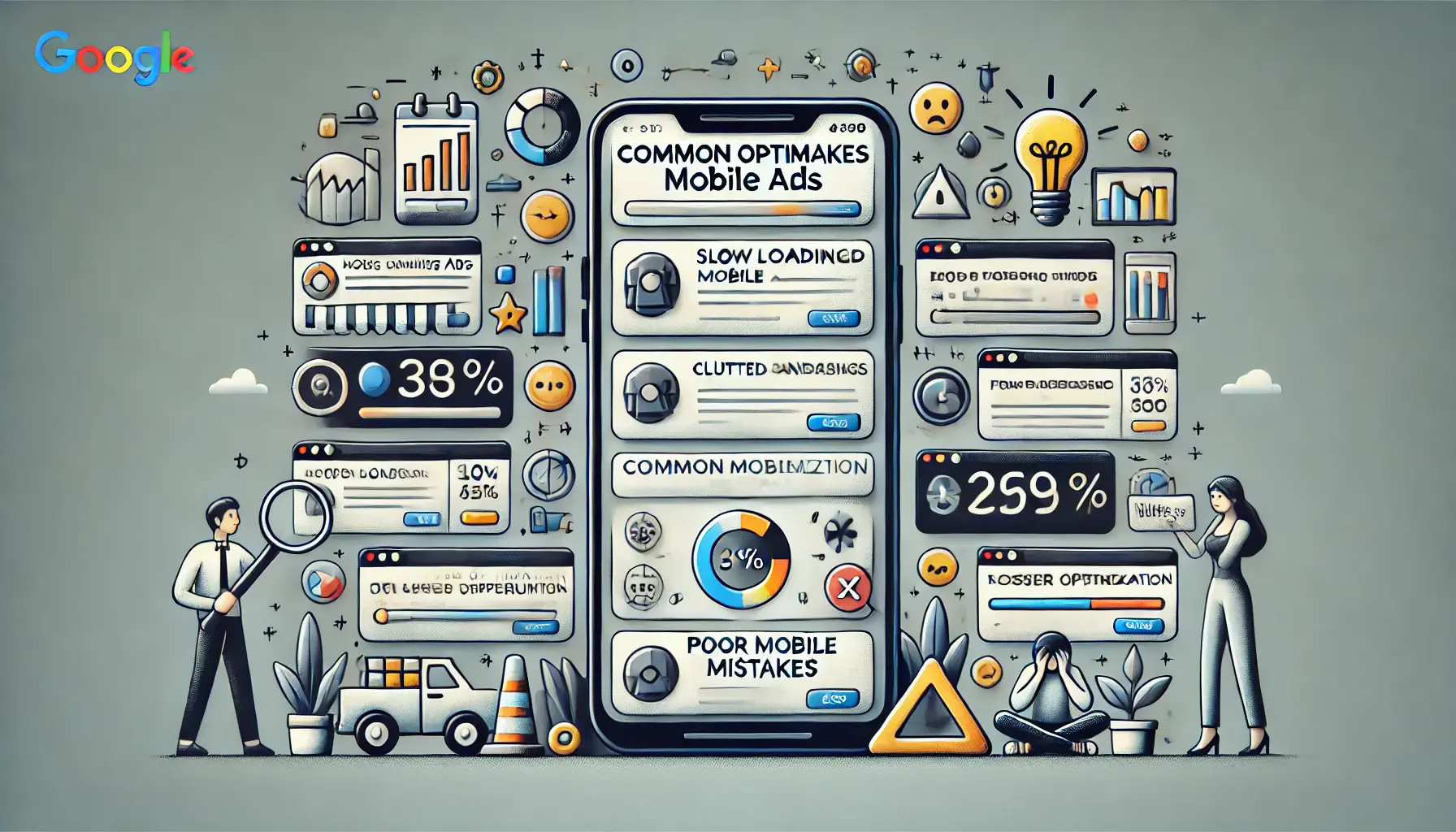
An illustration showing the negative impact of common mobile optimization mistakes, such as slow loading times and cluttered designs, on ad performance.
Common Mistakes in Mobile Optimization for Google Ads
Even the best-planned Google Ads campaigns can fall flat if common mistakes in mobile optimization are made.
Poor user experience, wasted ad spending, and reduced conversion rates are some of the many side effects of these errors.
Identifying and avoiding these mistakes will lead to improved performance and better results from your mobile campaigns.
Here are some of the most common mistakes marketers make when optimizing for mobile, and how to fix them.

An illustration showing the consequences of ignoring page speed optimization, such as slow-loading ads leading to poor user experience and high bounce rates.
Ignoring Page Speed Optimization
One of the most critical factors for mobile optimization is page speed.
Mobile users expect fast loading times, and any delay can lead to users abandoning the site.
If your landing pages load slowly, you risk losing customers before they even engage with your content.
Studies have shown that increasing page load time from 1 to 3 seconds increases the likelihood of a bounce by 32%.
To avoid this mistake, focus on the following:
- Optimized Images: Use compressed, optimized images that load quickly without compromising visual quality.
- Leverage Browser Caching: Enable browser caching so returning visitors don’t have to reload the entire page from scratch.
- Use Accelerated Mobile Pages (AMP): AMP is a framework designed to create fast-loading pages for mobile devices, improving both user experience and SEO rankings.
- Minimize JavaScript and CSS: Reduce the amount of JavaScript and CSS to ensure faster load times.
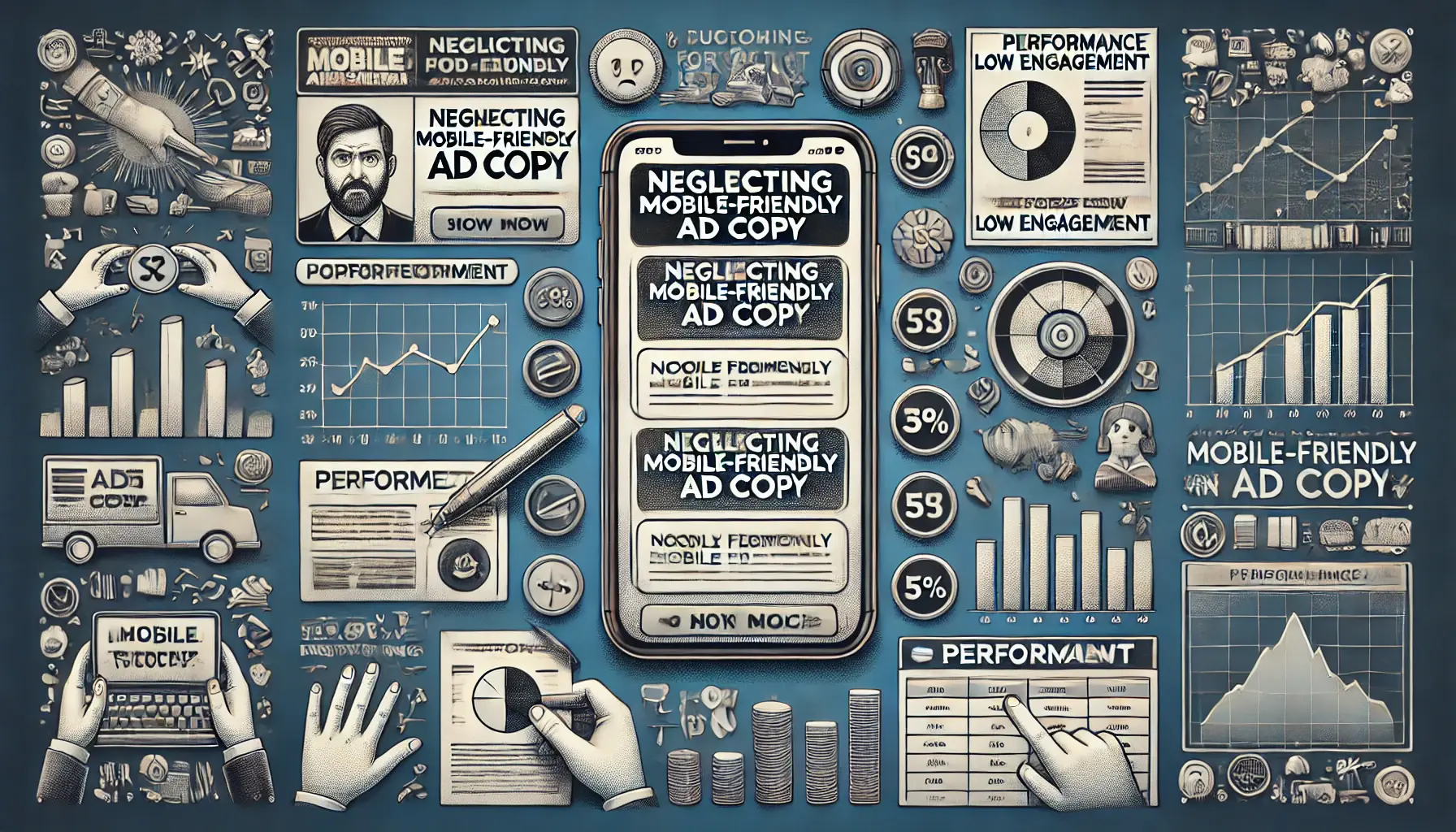
An illustration showing the consequences of neglecting mobile-friendly ad copy, such as poor formatting leading to low engagement and user frustration.
Neglecting Mobile-Friendly Ad Copy
Not tailoring ad copy for mobile devices can lead to lower engagement and missed opportunities.
Your mobile ad copy should be short, clear, appealing, and direct, with strong calls to action that encourage users to click through.
Key tips for writing mobile-optimized ad copy include:
- Keep It Short: Write shorter headlines and descriptions that fit well on mobile screens without overwhelming users.
- Focus on Benefits: Highlight the most important features and benefits of your product or service to capture user attention quickly.
- Use Strong CTAs: Include clear, actionable calls to action (CTAs) that encourage mobile users to take the next step, such as making a purchase, signing up, or contacting your business.

An illustration showing the consequences of overlooking device preferences in ad targeting, leading to poor user engagement and ad performance across devices.
Overlooking Device Preferences in Targeting
Mobile users behave differently from desktop users.
If you’re not segmenting your audiences or adjusting bids for mobile, you could be missing out on valuable opportunities.
To ensure you’re targeting the right users on mobile, follow these steps:
- Segment Audiences by Device: Create separate audience segments for mobile and desktop users to tailor your messaging and bidding strategies to each group.
- Use Mobile Bid Adjustments: Increase or decrease your bids based on how well your ads perform on mobile devices compared to other platforms.
- Monitor Device Performance: Regularly check how your ads perform across different devices and adjust your strategies to maximize mobile conversions.

An illustration showing the negative impact of failing to use mobile-specific bidding strategies, leading to poor ad performance and lost opportunities.
Failing to Use Mobile-Specific Bidding Strategies
Using the same bidding strategy across all devices can limit the effectiveness of your mobile ads.
Mobile ad spaces are highly competitive, and without mobile-specific bidding strategies, your ads may not reach their full potential.
Consider these tips to enhance your mobile bidding strategy:
- Set Mobile-Specific Bids: Set your bids specifically for mobile devices to prioritize mobile traffic and increase ad visibility.
- Use Enhanced CPC on Mobile: Enable Enhanced CPC (ECPC) to automatically adjust your bids in real time, helping you capture more mobile conversions.
- Target High-Intent Mobile Users: Focus your bids on high-intent mobile users, such as those near your physical store or searching for urgent solutions.
Avoiding these common mistakes in mobile optimization will help you create a better user experience, leading to higher conversions for your Google Ads campaigns on mobile devices.
Ignoring page speed, neglecting mobile-friendly ad copy, and failing to use mobile-specific bidding strategies are common mistakes that reduce the effectiveness of mobile campaigns.

An illustration showing how mobile optimization drives the success of Google Ads campaigns by improving ad performance and user engagement.
Mobile Optimization: The Key to Success of Google Ads Campaigns
Currently, mobile optimization in Google Ads is not an option but a necessity.
With more mobile users dominating the digital landscape every day, failing to target them effectively leads to missed opportunities, unsatisfactory user experiences, and lower returns on investment.
Throughout this article, we’ve discussed key strategies, best practices, and common mistakes in mobile optimization.
Implementing these insights will greatly enhance the performance of your Google Ads campaigns, ensuring you stay ahead in today’s mobile-first environment.
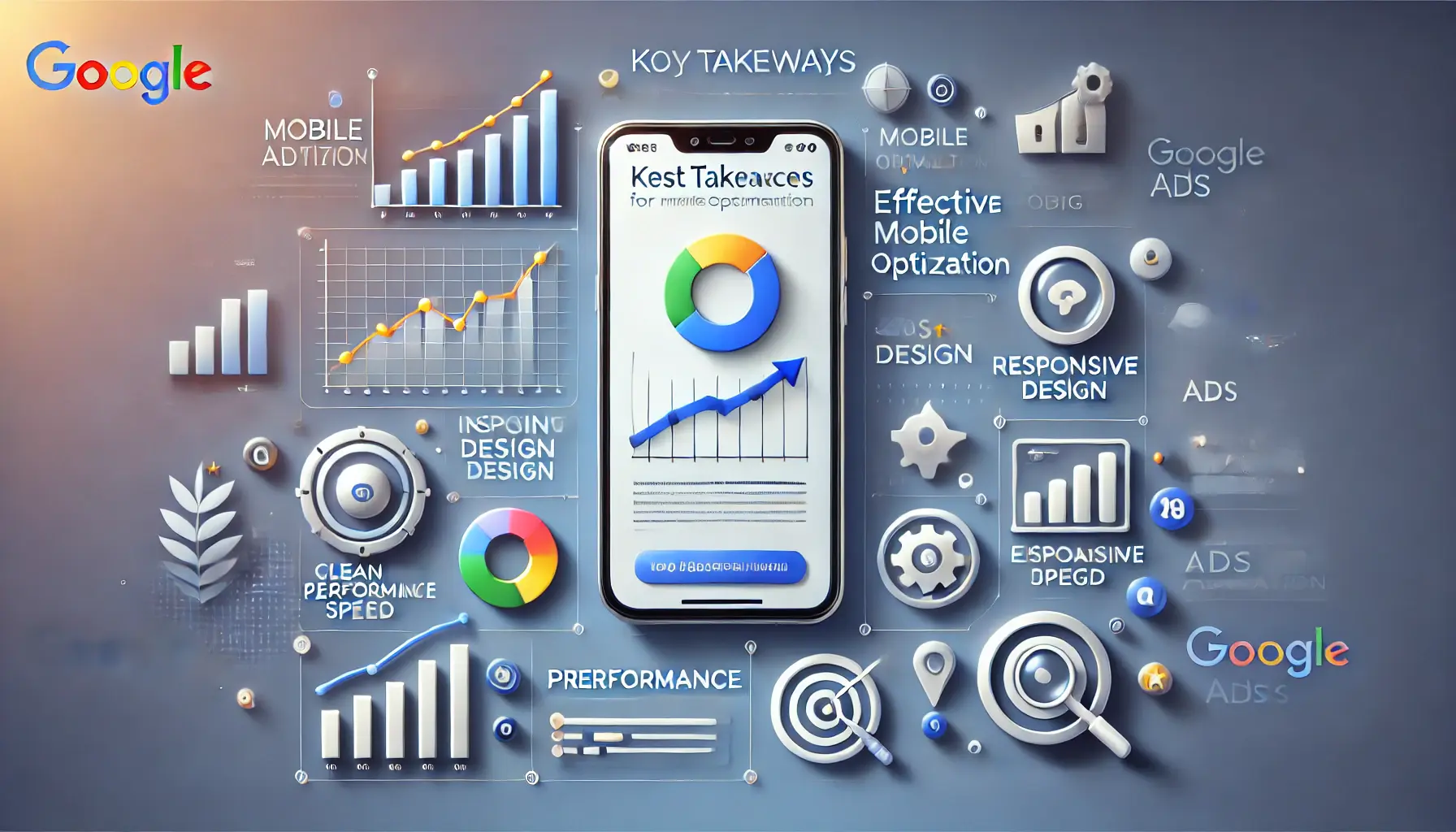
An illustration highlighting the key takeaways for mobile optimization, emphasizing responsive design, fast loading speeds, and improved ad performance.
Key Takeaways for Effective Mobile Optimization
From optimizing page speed to using mobile-specific bid adjustments, here are several key steps to elevate your mobile ad campaigns:
- Page Speed Optimization: Mobile users expect instant access to information. Improving image size, reducing JavaScript, and utilizing AMP will significantly boost load times and user experience.
- Mobile-Friendly Ad Copy: Keep your ad copy concise and benefit-driven to fit smaller screens. Strong calls to action will encourage users to take the next step.
- Targeting Mobile Audiences: Use location-based targeting, device bid adjustments, and audience segmentation to target mobile users accurately. Tailoring your strategy to mobile behaviors is key to driving conversions.
- Mobile-Specific KPIs: Track metrics such as conversion rates, CTR, and CPC specifically for mobile to ensure your campaigns are optimized for success. Tools like Google Analytics provide valuable insights into performance.
- Avoiding Common Mistakes: Don’t underestimate the importance of mobile page speed or device preferences, and avoid a one-size-fits-all bidding strategy. Tailoring your approach for mobile is crucial for campaign effectiveness.

An illustration representing the creation of a seamless mobile experience with smooth navigation, responsive design, and improved user engagement.
Creating a Seamless Mobile Experience
Meaningful optimization at every step of the user journey—from viewing an ad to landing on a mobile-optimized page—is essential.
The best-performing ads combine compelling content with a fast and smooth user experience.
Continuously monitor performance metrics, test various ad formats, and adjust your mobile campaigns based on evolving user behaviors to ensure consistent results.

An illustration showing how mobile optimization contributes to long-term success in digital advertising through improved ad performance and sustained growth.
Why Mobile Optimization is a Must for Long-Term Success
As mobile traffic continues to grow, brands that invest in mobile optimization will see superior results both in the short and long term.
Mobile optimization in Google Ads helps modern consumers engage more easily when browsing, shopping, or interacting with brands on their mobile devices.
Refining your strategies to focus on mobile will increase your reach, improve ad quality, boost engagement, and drive higher conversion rates.

An illustration showing the conclusion of a successful mobile optimization strategy, highlighting the strong performance and sustained success of optimized mobile ads.
Conclusion
Mobile optimization is one of the most crucial elements of any digital advertising strategy today.
Prioritizing mobile-friendly design, leveraging data-driven KPIs, and avoiding common mistakes will help your Google Ads campaigns thrive in a mobile-first world.
By staying adaptable and optimizing your ads specifically for mobile users, you can ensure long-term success in an ever-evolving digital landscape.
Mobile optimization is essential for modern Google Ads campaigns, ensuring better engagement, improved ad quality, and higher conversion rates.
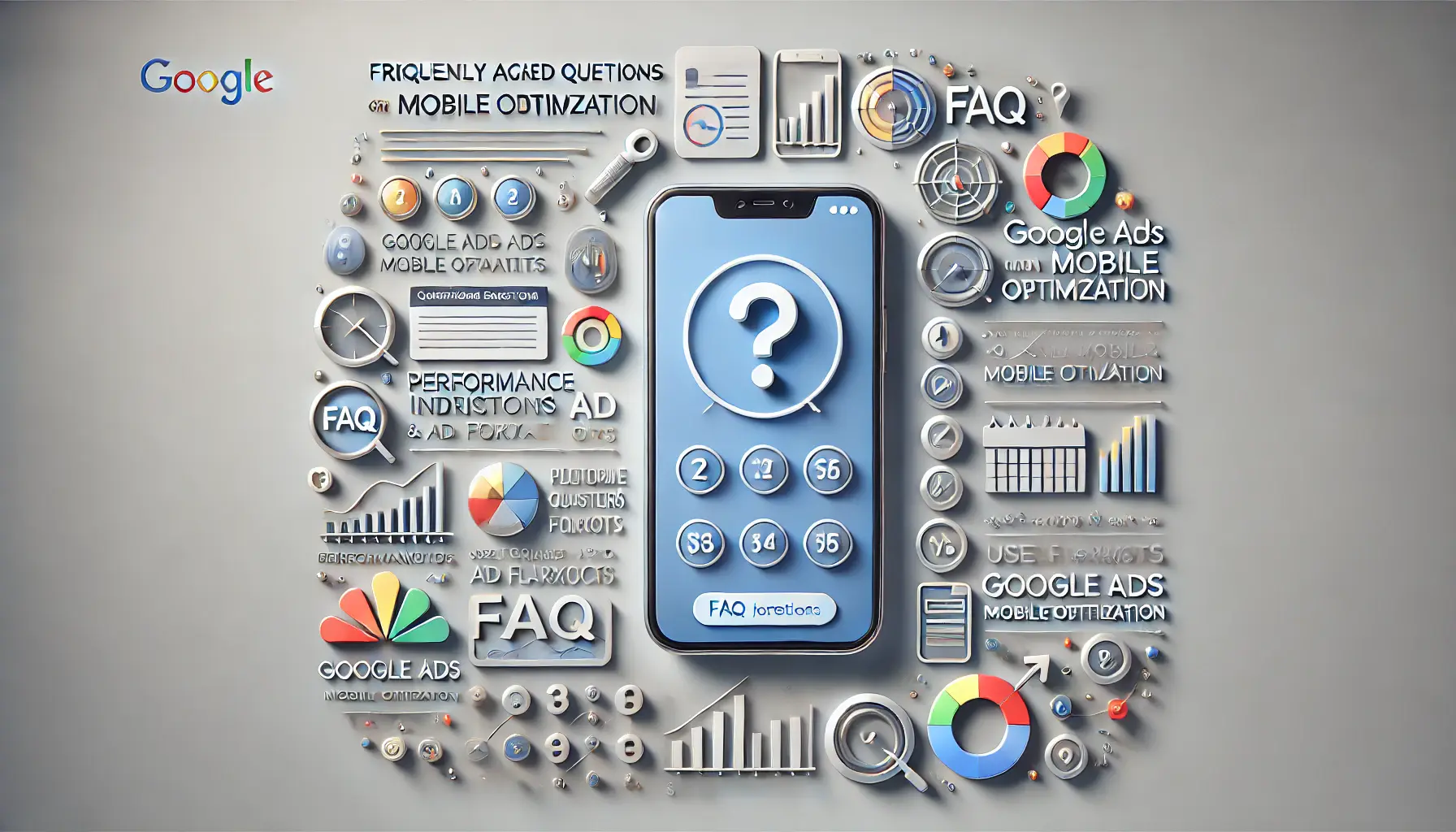
An illustration representing the FAQ section on Google Ads mobile optimization, highlighting common questions and insights about optimizing mobile ads.
Your campaigns can be managed by an agency specialized in Google Ads, check out our service page.
Google Ads Mobile Optimization: Frequently Asked Questions
Mobile optimization in Google Ads is crucial for marketers looking to improve campaign performance.
Below are some frequently asked questions that provide valuable insights and solutions on how to optimize Google Ads campaigns for mobile devices.
Mobile optimization in Google Ads involves making ad formats, landing pages, and bidding strategies efficient on mobile devices to provide a better user experience and improve campaign results.
Mobile page speed is critical because users expect fast-loading pages.
Slow loading times lead to high bounce rates, resulting in missed opportunities and a lower return on ad spend (ROAS) for your campaigns.
To improve mobile ad performance, optimize page speed, use concise ad copy, leverage mobile-specific bidding strategies, and track mobile-specific KPIs like CTR, conversion rates, and CPC to guide adjustments.
Mobile-specific KPIs include metrics like click-through rate (CTR), conversion rate, and cost-per-click (CPC) on mobile.
These KPIs offer insights into the effectiveness of your mobile ad campaigns and help optimize performance.
Mobile users make quicker decisions, prefer simplified navigation, and expect faster load times.
Understanding these differences allows you to customize ad formats and landing pages to increase mobile engagement and drive conversions.
AMP (Accelerated Mobile Pages) is a framework that enhances load times for mobile web pages.
It improves user experience, reduces bounce rates, and increases search engine rankings for mobile-optimized content.
In Google Ads, you can use mobile bid adjustments to increase or lower your bids depending on mobile performance.
Adjusting bids helps prioritize mobile traffic and optimize your ad spend based on mobile campaign results.
Cross-device tracking shows how users interact with ads across multiple devices, such as starting a conversion on mobile and completing it on desktop.
It provides a broader view of the customer journey and campaign performance.
To create mobile-friendly ad copy, keep it short, focus on key benefits, and use strong calls to action.
This ensures that your message resonates with mobile users who prefer concise, actionable information.













